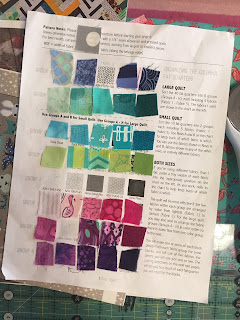I've thought about this a lot over the years. I started quilting in the early 90's. My initial motivation was to make a connection with my mom. She was taking a quilting class and invited me to come with her. We hadn't done anything fun together in awhile. I had a young son, and needed to get away, so I signed up. Once I got a taste of the sisterhood...I was hooked! There is something so inexplicable about the sisterhood of quilters! It is like nothing I have ever experienced. I didn't have a sister growing up, but I can imagine that it might have been something like what I feel for my group of quilting friends. We laugh together. We share our moments of joy and our moments of sorrow together. What happens at retreat, stays at retreat! It's a sorority of sorts.
I would imagine that most of you began your quilting journey with a grandmother, a mom, or a friend. If not, I would bet that you quickly found a sisterhood among those that you sat next to in your very first quilting class, and you've never looked back.
Another reason that we quilt has to be the sheer joy of creating. I believe that we were created to enjoy beauty. Look at the world around us. There is an explosion of color and creativity all around us. The flowers, the trees, the skies, the seas...it's all there for us to marvel at its beauty. We admire it and desire to create beauty ourselves. There are many ways to do that. Whether it is through painting, drawing, cooking, gardening, writing, sewing, decorating, photography, or any number of other activities, we can add beauty to our lives. Many of us enjoy several of these creative pursuits.
For me, over the course of my life, I have done painting on fabric, macrame, leather work, crochet, scrapbooking, colored pencil drawing, photography, home decorating, sewing clothing, scrapbooking, gardening, counted crossed stitch, embroidery, and finally quilting. I say "finally" because, in quilting, I have found my passion. There is nothing I enjoy more than the creative process of choosing a pattern, finding fabrics in colors and patterns that are pleasing to my eye, cutting and sewing as precisely as I can, and then quilting on my longarm a beautiful project. (notice I did not mention binding!)
Finally, I think a reason that we quilt is an innate desire to leave something behind. To give to others something that is a part of us and will possibly last longer than we will is such a special thing. I make quilts for my loved ones hoping that one day, when I am no longer here, they will wrap themselves in that quilt and remember how much I loved and cared for them. My hope is that the pews at my funeral will be covered with quilts, and that everyone who wants one to remember me will take one home. That is a legacy that is something I can feel good about.
 |
| My latest project: 100 Modern Block: Tula Pink's City Sampler |























